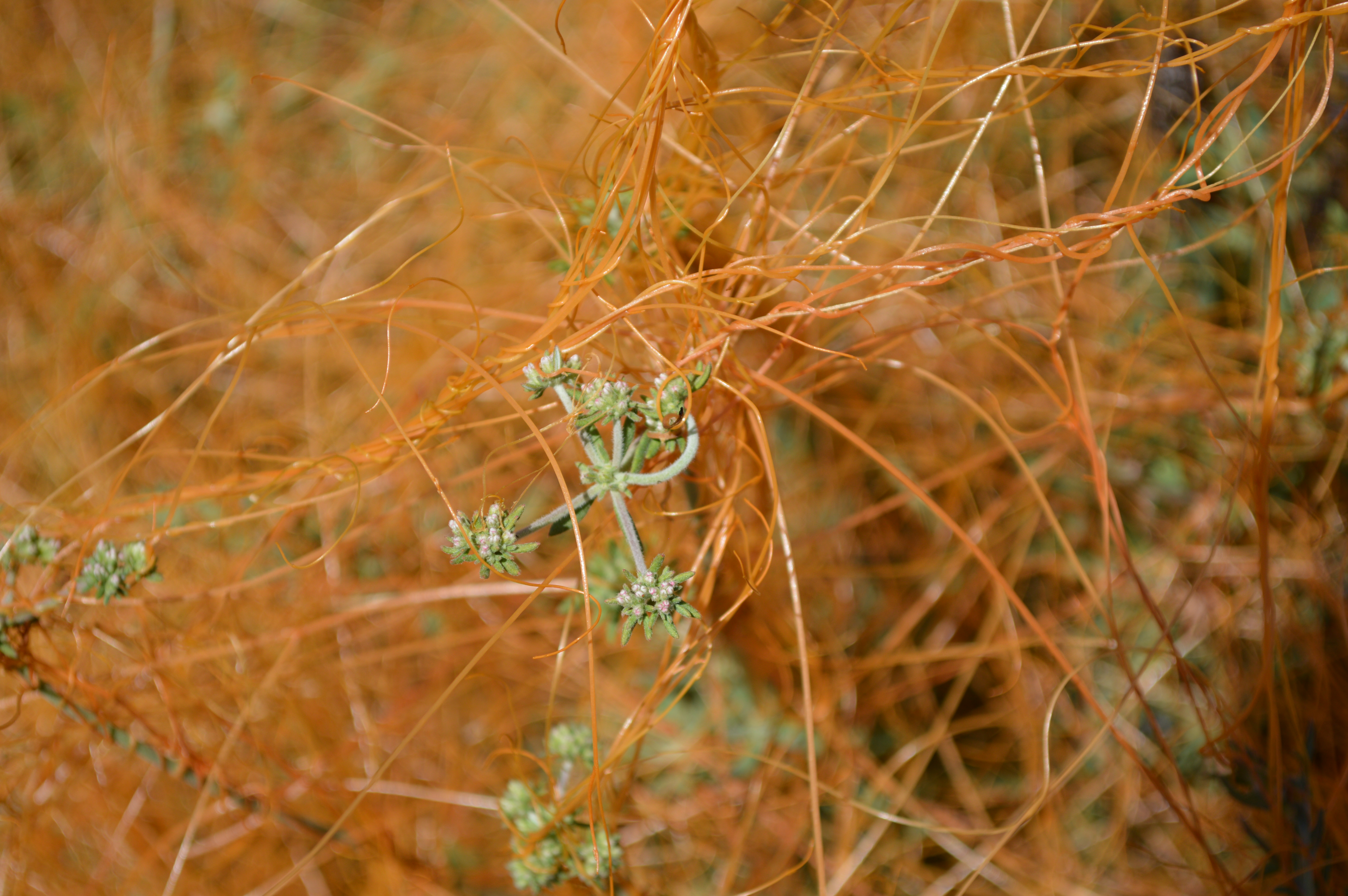
Parasitism/disease
Cuscuta parasitizes native plants
Photo Credit: Emily Perkins, SDMMP
|
Cactus Fungal Pathogen (Alternaria sp.)
This page provides information on the cactus dieback that was recently (2021) discovered on cactus (Opuntia littoralis) at a nursery in San Pasqual Valley and one restoration site sourced with the nursery cactus in Bandy Canyon. Recent findings from the Department of Plant Pathology, UC Davis pathogenicity tests show that the most frequent fungal species on the diseased cactus are a variety of Alternaria species. The plant pathology lab will next conduct greenhouse experiments to evaluate the effect of environmental factors such as humidity and water availability on disease severity. Information from this study will be used to develop best management practices for land mangers.
|
|
Golden Eagle (Aquila chrysaetos) Monitoring and Management Plan
Golden eagles (Aquila chrysaetos) face many threats in southern California. To reduce these threats and successfully conserve this species in western San Diego County, MSP Roadmap 2021-2026 objectives include the development and implementation of a “Management Strategic Plan for Golden Eagles in San Diego County†and a “Monitoring Strategic Plan for Golden Eagles in San Diego Countyâ€. These plans include general sections with background information and rationale for prioritizing and developing monitoring and management recommendations. Previously, the U.S. Geological Survey (USGS) in collaboration with local, State, and other Federal agencies has conducted a multi-year research study of golden eagles to address questions regarding habitat use, movement behavior, nest occupancy, genetic population structure, and human impacts on eagles. From 2016-17, occupancy analyses were conducted and it was concluded that estimates of occupancy were greatest at sample sites with more rugged terrain conditions, lower human development, and lower amounts of scrubland vegetation cover (Weins et al. 2022). Tracking data from the last 10 years in the Western Unites States have shown eagles exhibit long-distance, nonroutine movements that were responsive to the updraft potential of the spatial and temporal landscape they encountered (Poessel et al. 2022). For the development of both Plans, chapters will be shaped based on the latest scientific information regarding occupancy, natal nesting success, juvenile dispersal, movement and biotelemetry, home range estimation, habitat use, and prey availability. Site-based threats assessment will be used to determine the best management practices. These plans are developed with input and guidance provided by the San Diego Golden Eagle working group, which includes include landowners and managers, scientists, species experts, and representatives from non-profit organizations, government, and wildlife agencies. Occurrence-specific management recommendations will be based on working group input and multiple years of data on Golden Eagle population status, habitat associations, and threats. These are living documents as the plans will be updated when new information becomes available or management actions are completed, and new recommendations are needed.
|
|
Rabbit Hemorrhagic Disease (RHDV2)
Rabbit hemorrhagic disease (RHDV2) was detected in Palm Springs in March 2020 and Ramona in April 2021. It is highly contagious and often lethal to wild and domestic rabbits, hares, and pikas. Infected rabbits may or may not exhibit symptoms leading up to their death. Symptoms are rabbits may suffer are fever, swelling, inappetence, lethargy, spasms, breathing difficulties, blue colored lips or mucous membranes, bleeding from body cavities, and liver necrosis. The disease is transmitted to rabbits through contact with other infected rabbits or carcasses, their meat or their fur, contaminated food or water, or materials coming into contact with them. The virus can persist in the environment for a very long time, making disease control efforts extremely challenging once in wild rabbit populations.
|
| File name | Lead Author | Year | Type |
|---|---|---|---|
| Bat virome study and ties to emerging infectious diseases | Fisher, Robert N. | 2022 | powerpoint presentation |
| Discovery of a New Plant/Pathogen Relationship in San Diego County | Dunn, Jonathan | 2021 | powerpoint presentation |
| Elucidating the Causes of Opuntia littoralis Decay in Native Nurseries and Restoration Sites in Southern California | Acker, Sophia; Arndt-Truong, Dimitri; Kashyap, Ruchika; Matthews, Derrick; Del Castillo Múnera, Johanna | 2023 | other |
| Guidance for Cleaning and Disinfection of Rabbit Hemorrhagic Disease Virus (RHDV) Contaminated Premises | 2020 | fact sheet | |
| Photo Progression - Cactus Fungal Pathogen (Fusarium brachygibbosum) | Wehinger, Kim | 2021 | other |
| Quick Facts About Rabbit Hemorrhagic Disease | 2021 | fact sheet | |
| Rabbit Hemorrhagic Disease (RHDV2) Overview | 2021 | powerpoint presentation | |
| Recording - November 2022 MSP Land Managers Meeting | Vinje, Jessie; Rodes, Rusty; Lombardo, Dario; Copenhaver, Paige | 2022 | recording |